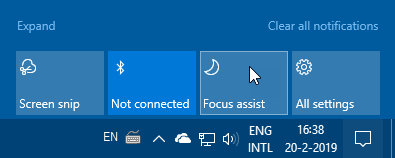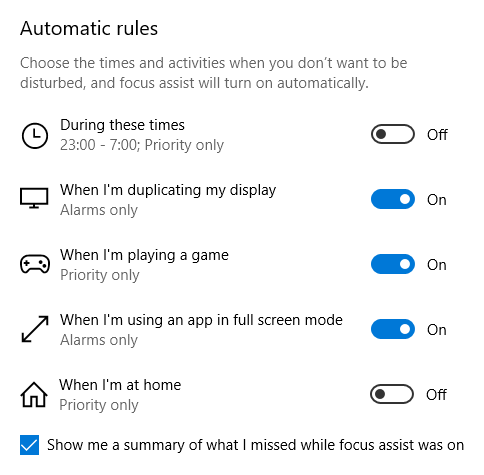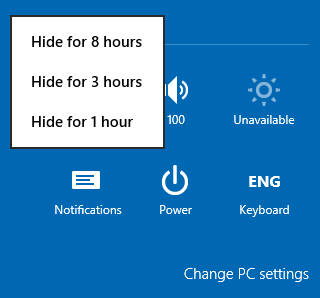Focus Assist; Don’t let yourself get distracted by emails!
We all have these moments; You need to focus and don’t want to get distracted by anything for a longer period of time.
Alerts for incoming emails can be quite a distraction and those emails you thought only required a quick and short responds ended up becoming an essay or a back-and-forth conversation or just totally got you out of your rhythm.
Of course, you could close Outlook and all other applications that generate pop-up alerts or sounds, but did you know about Focus Assist already?
 Focus Assist isn’t a completely new feature in Windows 10, but it is one of those small “hidden gem” features that they keep improving upon with each feature release of Windows 10.
Focus Assist isn’t a completely new feature in Windows 10, but it is one of those small “hidden gem” features that they keep improving upon with each feature release of Windows 10.
It is now really intuitive to use and I actually find myself using it more often.
Focus Assist in Windows 10
Focus Assist in Windows 10 is basically nothing more than an on/off switch for the feature but it can also be configured to turn itself on or off based on certain conditions.
When it is enabled, notifications for applications that integrate with the Action Center of Windows 10 will no longer be shown or make a sound unless you’ve created an exception for it.
All the notifications that you’ve missed are still collected in the Action Center so when you are ready to turn off Focus Assist, you’ll immediately see an overview of these missed notifications.
You can enable Focus Assist via the Action Center and it has 3 states which gets selected in the following order each time you click on it;
- Off
Get all notification from your apps and contacts. - Priority only
See only selected notifications from the priority list. The rest will go straight to action center. - Alarms only
Hide all notifications, except for alarms.

Focus Assist in the Action Center.
Note: If you don’t see the Focus Assist button, you may need to click on Expand first.
Extra Tip: Another quick way to toggle Focus Assist is by right clicking on the Action Center icon. This will open a context menu which also contains a Focus Assist entry which allows you to select one of the 3 states.
To configure Focus Assist Automatic Rules, right click on the Focus Assist icon and choose: Go to Settings.
You can also access these settings via;
- Start-> Settings-> System-> Focus assist
Aside from turning the rule on or off, you can also click on it to configure the hours, the focus level, a notification when it is turned on, etc…

You can configure Focus Assist rules by clicking on them.
Note: Which Automatic Rules are available to you depends on your device type (desktop, laptop, tablet, etc…) and update level of Windows 10.
Quiet Hours in Windows 8
 Quiet Hours in Windows 8 is similar to Focus Assist in Windows 10 (in fact: Focus Assist used to be called Quiet Hours on Windows 10 as well) but lacks the quickly accessible on/off switch.
Quiet Hours in Windows 8 is similar to Focus Assist in Windows 10 (in fact: Focus Assist used to be called Quiet Hours on Windows 10 as well) but lacks the quickly accessible on/off switch.
However, even though it originally had the same name, it turned into a completely different feature. Even when you have Quiet Hours turned on in Windows 8, as soon as it detects that you are using your computer, you’ll start receiving notifications again.
To turn Quiet Hours on or off:
- Open the Charm Bar and choose Settings or use the Windows key + I keyboard shortcut.
- Choose: Change PC settings
- Choose: Search and apps
- Choose: Notifications
- Section: Quiet hours
The feature that comes closest to the Focus Assist feature in Windows 10 is to hide the notifications for a certain amount of time.
- Open the Settings Panel (Windows key + I).
- Click on the Notifications icon and choose one of the following:
- Hide for 1 hour
- Hide for 3 hours
- Hide for 8 hours
To re-enable the notifications again, simply click on the Notifications icon itself.

Hide Notifications in Windows 8.
Extra Tip: Hide notifications while presenting
 Also, don’t forget that Windows has a Presentation Mode application which allows you to pre-configure some setting changes like disabling your screensaver, setting your sound level and adjusting your background (like to a corporate one instead of your personal one) with the click of a button.
Also, don’t forget that Windows has a Presentation Mode application which allows you to pre-configure some setting changes like disabling your screensaver, setting your sound level and adjusting your background (like to a corporate one instead of your personal one) with the click of a button.
This will also hide various notifications and silence sounds that are not part of your presentation.

